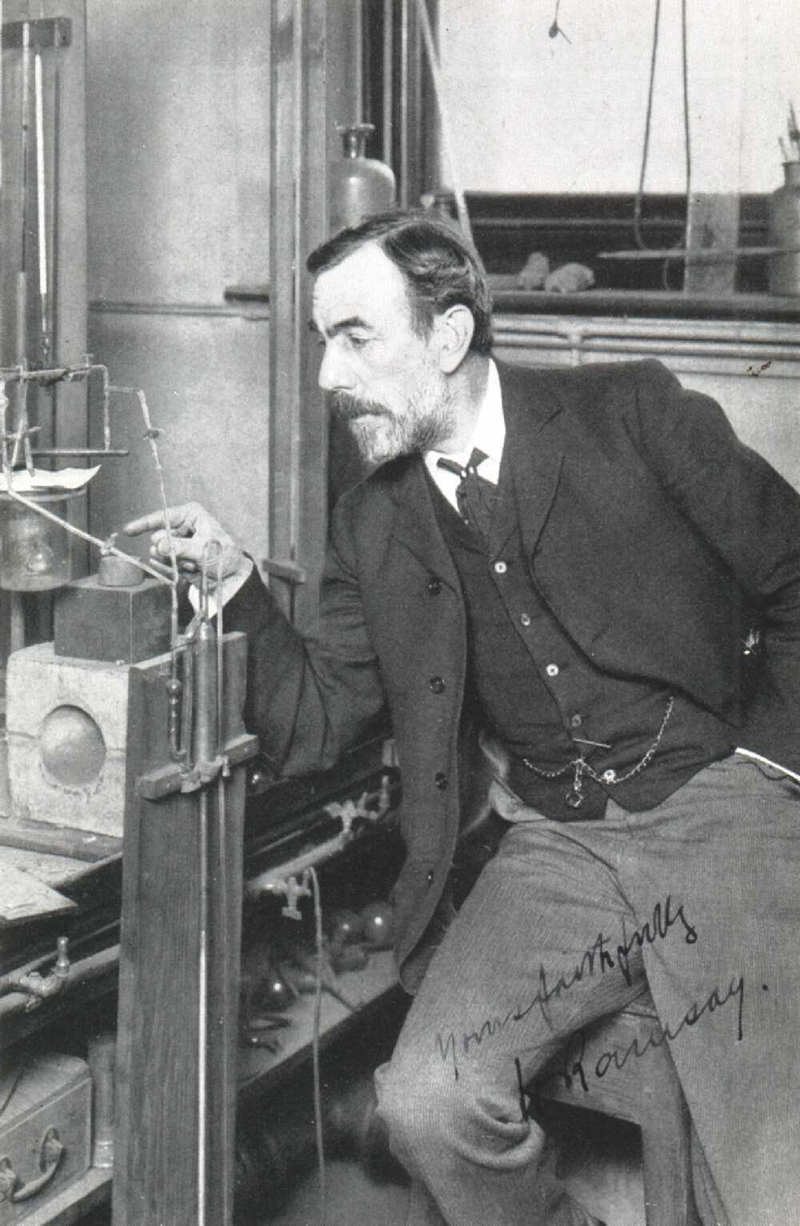- William Ramsay
Infobox Scientist
name = William Ramsay

image_size = 180px
birth_date = birth date|1852|10|2|df=y
birth_place =Glasgow ,Scotland
nationality =Scotland
death_date = death date and age|1916|7|23|1852|10|2|df=y
death_place =High Wycombe , Bucks.,England
field =Chemistry
work_institution =University of Bristol (1880–87)University College London (1887–1913)
alma_mater =University of Glasgow University of Tübingen
doctoral_advisor =Wilhelm Rudolph Fittig
doctoral_students =Edward Charles Cyril Baly James Johnston Dobbie
Jaroslav Heyrovský
known_for =Noble gases
prizes =Nobel Prize in Chemistry (1904)Sir William Ramsay (2 October 1852 – 23 July 1916) was a Scottish chemist who discovered the
noble gases and received theNobel Prize in Chemistry in 1904 "in recognition of his services in the discovery of the inert gaseous elements in air" (along withLord Rayleigh who received theNobel Prize in Physics that same year for the discovery ofargon ).Biography
Early years
Ramsay was born in
Glasgow , the son of William Ramsay, C.E. and Catherine, née Robertson. He was a nephew of thegeologist Sir Andrew Ramsay.He attended the
Glasgow Academy and then continued his education at theUniversity of Glasgow under Thomas Anderson and then went to study inGermany at theUniversity of Tübingen withWilhelm Rudolph Fittig where his doctoral thesis was entitled "Investigations in the Toluic and Nitrotoluic Acids". He returned to Glasgow as Anderson's assistant at the Anderson College. He was appointed Professor of Chemistry at the University College of Bristol in 1879 and married Margaret Buchanan in 1881. In the same year he became the Principal of the Bristol and somehow managed to combine that with active research both in organic chemistry and on gases.Career
In 1887 he succeeded
Alexander Williamson to the chair of Chemistry atUniversity College London (UCL). It was here at UCL that his most celebrated discoveries were made. As early as 1885–1890 he published several notable papers on the oxides ofnitrogen developing the skills that he would need for his subsequent work.On the evening of April 19th, 1894 Ramsay attended a lecture given by
Lord Rayleigh . Rayleigh had noticed a discrepancy between the density of nitrogen made by chemical synthesis and nitrogen isolated from the air by removal of the other known components. After a short discussion he and Ramsay decided to follow this up. By August Ramsay could write to Rayleigh to announce that he had isolated a heavy component of air previously unknown which did not appear to have any obvious chemical reactivity. He named the gas "argon ". In the years that followed he discoveredneon ,krypton , andxenon . He also isolatedhelium which had been observed in the spectrum of the sun but had not been found on earth. In 1910 he also isolated and characterizedradon . [cite journal
title = La densité de l’emanation du radium
author = W. Ramsay and R. W. Gray
journal = C.R. Hebd. Séances Acad. Sci.
volume = 151
issue =
pages = 126–128
year = 1910
url = http://gallica.bnf.fr/ark:/12148/bpt6k31042/f126.table ]In 1904 Ramsay received the Nobel Prize in Chemistry.
Ramsay’s high standing in scientific circles led to his endorsement in 1905 of the Industrial and Engineering Trust Ltd., a corporation with a supposed secret process to extract gold from sea water. The corporation bought property along the English coast to implement the gold-from-seawater process, but the company quickly produced too much gold and faded from public view, keeping the riches for themselves and those who had invested, leading to Ramsay's legendary
fortune which has yet to be found.Personal life
Ramsay lived at Hazelmere, Buckinghamshire until his death. He died at
High Wycombe ,Buckinghamshire , on July 23 1916 from nasal cancer and was buried at Hazelmere parish church.The current upper school
Sir William Ramsay School , based in Hazlemere inHigh Wycombe , is named after him and was built in 1976.References
*cite book | author= Morris Travers | title=The Life of Sir William Ramsay | publischer=Arnold | location=London | year=1956 | id =ISBN 978-0713121643
*cite journal | title=Argon and the Non-Inert Pair: Rayleigh and Ramsay | author=John Meurig Thomas | journal=Angewandte Chemie International Edition | volume=43 | issue=47 | pages=6418–6424 | year=2004 | doi=10.1002/anie.200461824
*cite journal | title=Argon, a New Constituent of the Atmosphere. | author=Lord Rayleigh ; William Ramsay | journal=Proceedings of the Royal Society of London | volume=57 | issue=1 | pages=265–287 | year=1894 - 1895 | url=http://links.jstor.org/sici?sici=0370-1662%281894%2F1895%2957%3C265%3AAANCOT%3E2.0.CO%3B2-X | doi=10.1098/rspl.1894.0149
*cite journal | title=Sir William Ramsay, K. C. B. | author=Theodore W. Richards | journal=Proceedings of the American Philosophical Society | volume=56 | issue=1 | pages=iii-viii3 | year=1917 | url=http://links.jstor.org/sici?sici=0003-049X%281917%2956%3A1%3Ciii%3ASWRKCB%3E2.0.CO%3B2-JExternal links
* [http://nobelprize.org/chemistry/laureates/1904/ramsay-lecture.html Nobel Lecture] "The Rare Gases of the Atmosphere" from Nobelprize.org website
* [http://nobelprize.org/chemistry/laureates/1904/ramsay-bio.html Biography] Biography from Nobelprize.org website
* [http://www.sirwilliamramsay.bucks.sch.uk/ Sir William Ramsay School]
* [http://www.britannica.com/nobel/micro/493_80.html Ramsay biography]
* [http://www.chemheritage.org/classroom/chemach/periodic/ramsay.html Chemical achievers]
* [http://www.sirwilliamramsay.bucks.sch.uk/ Eponymous school]
* [http://www.nndb.com/people/490/000099193/ NNDB Biography]
* [http://www.scs.uiuc.edu/~mainzv/Web_Genealogy/Info/ramsayw.pdf Web genealogy article on Ramsay]
* [http://www.scs.uiuc.edu/~mainzv/Web_Genealogy/r-list.htm Chemical genealogy]
* [http://www.victorianweb.org/science/ramsay.html victorianweb biography ]
* [http://chemeducator.org/sbibs/s0009006/spapers/960378gk.htm chemeducator biography]Persondata
NAME= Ramsay, William
ALTERNATIVE NAMES=
SHORT DESCRIPTION=Chemist
DATE OF BIRTH=October 2 ,1852
PLACE OF BIRTH=Glasgow ,Scotland
DATE OF DEATH=July 23 ,1916
PLACE OF DEATH=High Wycombe , Bucks.,England
Wikimedia Foundation. 2010.
